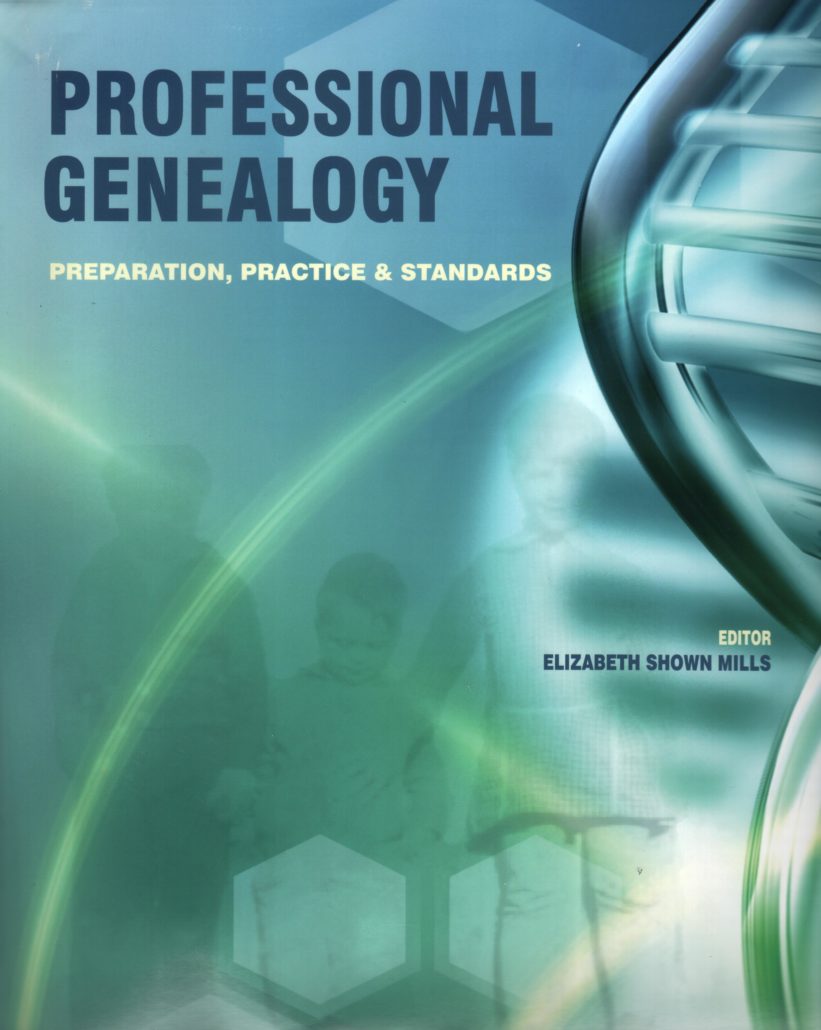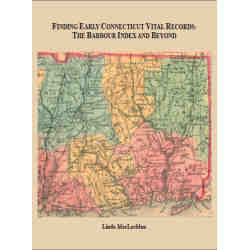
“Tree Talks” is the journal of the Central New York Genealogical Society, based in Syracuse, New York. The magazine is now in its 59th year of publication, and its contents are followed by researchers from around the U.S. who have New York ancestry. “Tree Talks” reviewed two of our books in recent issues. The March 2019 issue (Vol. 29, No. 1) carries a detailed assessment of Professional Genealogy: Preparation, Practice & Standards, edited by Elizabeth Shown Mills. The June issue reviewed our 2016 but still highly relevant book, History for Genealogists: Using Chronological Timelines to Find and Understand Your Ancestors, by Judy Jacobson with additions and corrections by Denise Larson. We have reproduced both reviews for this issue of “Genealogy Pointers.”
BOOK REVIEW by Nancy Ward Remling
PROFESSIONAL GENEALOGY: PREPARATION, PRACTICE & STANDARDS. By Elizabeth Shown Mills. Genealogy Publishing Co., Baltimore, MD., 2018.. ISBN 987-0-632-0724. Hard cover, $47.37. 678 pgs., illus. indexed.
This book is intended for professional genealogists, but it is not only for the professional. Rather, many of the chapters will benefit any genealogist who wants to do quality work on their family tree. It is really a sequel to her 2001 book, Professional Genealogy: A Manual for Researchers, Writers, Editors, Lecturers, and Librarians, not an update. Although it does cover many of the same topics, it was written with today’s standards and methods in mind.
The book is divided into six main areas: Professional Preparation; Ethics & Legalities; Career Management; Professional Research Skills; Writing, Editing & Publishing; and Educational Services.
Each section is obviously valuable to the professional, but also for the amateur genealogist. If you’ve never thought about starting your own business, doing genealogy for others, many sections might seem irrelevant to you. However, do you ever help out another genealogist with their research? Having an idea of the ins and outs of ethical and legal dilemmas of the professional will be helpful in knowing what to do if you reach a tricky situation while assisting someone else.
Thinking of hiring a professional to help with your own research? Understanding what preparation that professional has undertaken will help you know what to expect. Don’t overlook the chapters on contracts in the Ethics and Legalities section. Any large project will definitely involve a contract between you and a professional.
The section on Educational Services will give insight for those looking to bring in speakers and teachers to any society. Yes, there is a difference between lecturing and teaching. Read these chapters to discover some of the differences and their importance.
Many chapters apply to everyone performing research. For instance, the section on Professional Research Skills can help anyone. Perhaps you’re only researching for yourself or your family. However, learning how to do better research and how to analyze what you’ve found is bound to be of benefit to you whether it is to get to the fun information quicker or how to tease out an answer to the problem that has been creating a brick wall for you. There’s also a brief overview of using DNA in genealogy.
The writing section can help you pull together a research report or create a genealogy to give to your family. Also, it can assist you in understanding what goes into the books and journals that you read on the subject. Even if you don’t plan on writing something for someone else, an informal research report can help anyone doing genealogy. Professionals often write these on their personal research for “the file.” These help them to remember what they were doing before being interrupted for a period of time and to pick up their research where they left off.
Professional Genealogy is not a book for beginners; it doesn’t go over in any detail the types of records that can be found. Rather it starts at a level of knowing the basics and goes from there. This is an excellent guide to doing genealogy on a higher level. Whether it’ s for the obvious application as a professional or the less obvious for amateur genealogists, it is worth reading. View Book Now
BOOK REVIEW by Joyce H. Cook
History for Genealogists: Using Chronological Time Lines to Find and Understand Your Ancestors, by Judy Jacobson. “Revised Edition with 2016 Addendum Incorporating Editorial Corrections to the 2009 Edition,” by Denise Larson. Clearfield Pub. Co., 2016. ISBN 978-0- 8063-5768-3. paperback $41. 310 pgs., 9 pg. bibliography, indexed.
There is so much information packed into this fairly short book that I thought it would be too dense and dull, but I found it fun and fascinating! Of course, that’s because I had already done a time line for several of my families so knew their value, and also I know that history and genealogy go hand in-hand, they cannot be separated.
The fun part came when I checked my birth year in many of the lists she provided as to what was happening in specific countries and states and found lots of interesting tidbits. However, I did use the lists for less frivolous searching, such as looking at the New York State list for events that might have affected my ancestors. The states’ time lines end in the late 1940s or in 1950; they start when there was recorded activity in that state for the first time, such as NYS in 1609 when Europeans discovered the Hudson River.
Most helpful were the chapters on why our ancestors left their homeland, whether due to military, political, religious, health, or even economic reasons. It wasn’t just the potato famine that drove the Irish out; there were other circumstances that made it impossible for them to stay in Ireland and made the United States seem a haven for them in the mid-1800s.
The author includes time lines of how people got to America, such as boat or railroad, and where they came from. Migration patterns are very informative for figuring out who came with whom; what’s known as community genealogy can be extremely helpful. As she says in a chapter on “Even Harder to Find Missing Persons,” people seldom disappeared alone. In fact, sometimes people didn’t disappear from public records; the location where they lived changed names and political jurisdiction and they hadn’t moved at all. Researchers just have to check in the right location.
The “Index of People and Places, Wars and Battles” is more comprehensive than I have seen before, especially because it refers to what’s on the lists throughout the book. Of course, the Civil War battles are indexed but so are the brief wars in Maine in the late 1600s.
Also fascinating are the tables in the first section. Because many of my families came from New England to New York State, I used the table on “Eastern trails and roads” to give ideas on how they got here. For example, the Greenwood Road went from Hartford to Albany; I hadn’t heard of it but now that needs further research.
She gives advice on how to construct a time line and where to find more information about this procedure online. The reason I started doing them is checking to see that I filled in as many years as possible. However, another valuable reason is to be sure your great-grandmother didn’t give birth to a child when she was five years old, for example. Or discovering that a birth was recorded before the parents were married. This definitely demands more research! And time lines are very effective in determining whether you are researching one person or perhaps two of the same name and location, at approximately the same time.
Not only lists and tables but the chapters on “Myths, Confusions, Secrets and Lies” are useful too. And the author reminds us to check local histories, diaries and journals, and social history books for clues to our ancestors and their peregrinations.
The two new chapters added in 2016 cover “1907 – 1947/48 Homefront” and “Fashion and Leisure,” the latter from 1550 – ·1961. There is a separate brief bibliography for the time lines in those chapters.
The material covered is world-wide, with lists of events for the New World from 1500 — 1950, and for Europe, Asia, and Africa from 1300 — 1950. The author provides us a brief tutorial on the changes from the Julian to the Gregorian calendar in the 1600s and 1700s and how this can affect our research.
As I said, this is a fun book to look through. It’s even more fun when you find lots of research and resources help, as I did!
Joyce H. Cook, Editor






